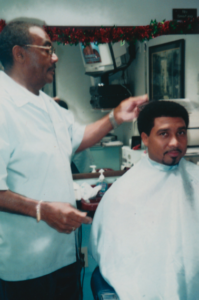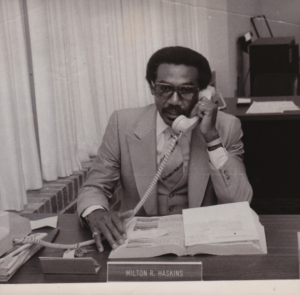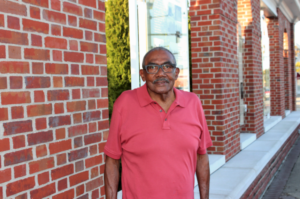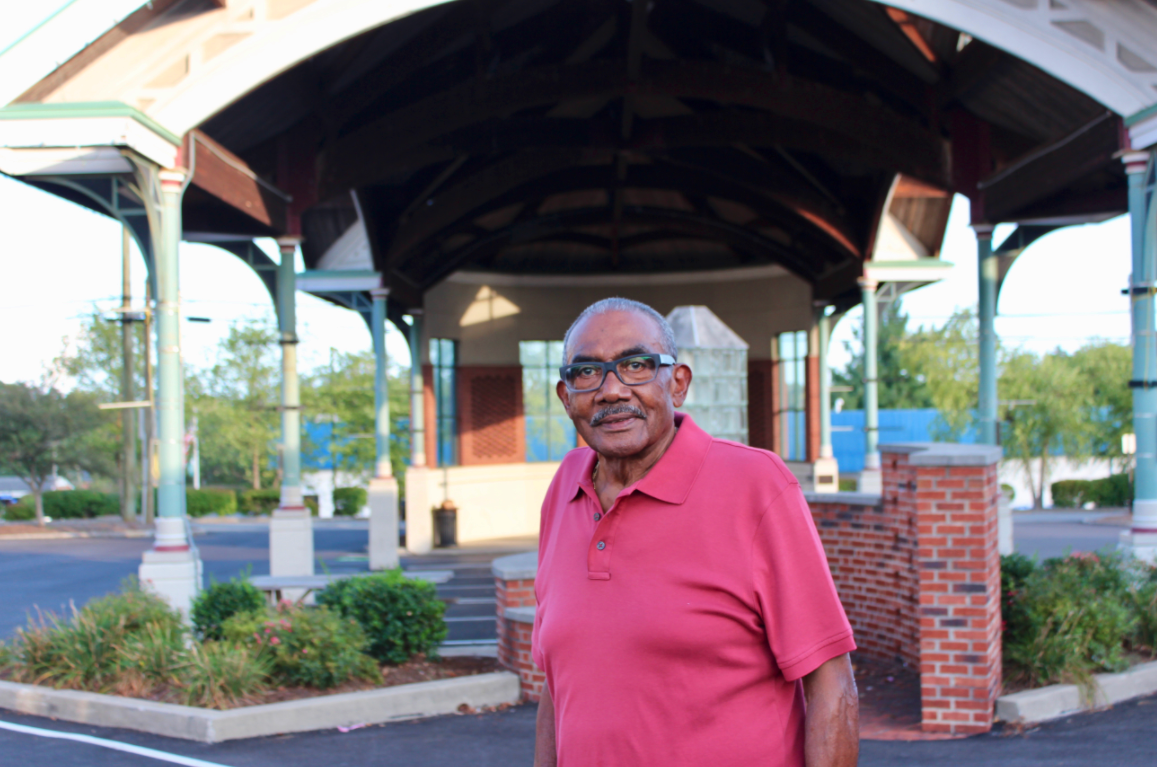Milton Haskins Reflects on Career and Community
Writer / Carrie Vittitoe
Photography Provided
 Some people might say a good barber or stylist is even better than a therapist. When you walk out of the shop, you not only feel better, but you look like a million bucks, too. Jeffersontown resident Milton Haskins spent more than 44 years of his life in a barbershop, and even though he has been retired since 2013, he says he is still adjusting to life beyond the blade.
Some people might say a good barber or stylist is even better than a therapist. When you walk out of the shop, you not only feel better, but you look like a million bucks, too. Jeffersontown resident Milton Haskins spent more than 44 years of his life in a barbershop, and even though he has been retired since 2013, he says he is still adjusting to life beyond the blade.
Early Years
Haskins spent his early years in Greensburg, Kentucky.
“I shined shoes when I was in elementary school in a white barbershop,” he says. “I grew up poor, and we didn’t have much of anything.”
He fondly remembers the owner of the shop, Miss Ada Kidd, taking him to a store to buy him clothes after he had seen items in the shop that he couldn’t afford.
“She spoiled me,” he says.
For high school, Haskins attended the Lincoln Institute, an all-black boarding school in Simpsonville, Kentucky. When he’d come home, he would shine shoes and make good money.
“A shoeshine was 25 cents but nobody gave me 25 cents,” he says. “The majority of the time it was 75 cents or a dollar,” he says.
When he was a teenager, the local sheriff would have Haskins shine his shoes every other day.
“He’d tell people, ‘I love this kid. I’d rather see him in here making an honest living than in the street acting a fool and getting in trouble. I’m going to keep him working,’” Haskins says.
Although he wanted to attend college and study engineering, he couldn’t afford the tuition. He went to West Kentucky vocational school and attended barber school, based on the encouragement of a friend.
“From West Kentucky, I came to Louisville, and that’s where I did my apprenticeship,” he says.
At the time apprenticeships were 18 months, and during that span of time he also held a job in the evenings. This was when Haskins says he fell in love with barbering.
 A year or so after his apprenticeship ended, on October 12, 1964, at the age of 24, Haskins and a colleague, William Curry, opened up a shop together on 22nd Street called C & H Barber Shop.
A year or so after his apprenticeship ended, on October 12, 1964, at the age of 24, Haskins and a colleague, William Curry, opened up a shop together on 22nd Street called C & H Barber Shop.
“At that time it was kind of scary,” Haskins says. “I had some guidance, but a lot of it I just had to figure out on my own.”
Eventually, Curry decided to open his own shop, so Haskins carried on as Haskins Barber Shop, and brought in a friend from West Kentucky to help him cut hair.
Haskins worked long days from 9:00 a.m. to 9:00 p.m., six days per week.
“During that time haircuts were cheap, and I just had to do it,” he says.
Haircuts cost $2 at the time, but when he retired he was getting $13.50 or so per haircut. Until he built up his clientele, some days would be slow. Of course, as the owner he did everything from giving haircuts to being the janitor. During this time, he was also busy being a father of two boys and two girls. While his children didn’t take up barbering as a profession, his grandson and granddaughter did go into the field.
Haskins had experience cutting hair for both white and black clients, and says when he first opened the 22nd Street shop it was a predominantly white neighborhood. No matter who his clients were, he expected and modeled respect in his business, and offered a relatability that clients appreciated. He wanted his shop to be a place where anyone felt comfortable, and wouldn’t allow cursing or any inappropriate behavior.
“You could bring your mother, your father, your sister, your brother, your preacher,” Haskins says. “I didn’t have any of that nonsense.”
Sports was a big topic of conversation in the shop, in part because Haskins’ nephew was the first black basketball coach at Western Kentucky. Haskins says he followed basketball and attempted to play but wasn’t that good.
Trends in Hair
As a barber for so many years, Haskins saw lots of hairstyle trends come and go.
 “When I first started, everybody was getting their hair cut close,” he says.
“When I first started, everybody was getting their hair cut close,” he says.
Eventually, afros became popular among black clients, and white clients started keeping their hair longer as well.
“Barbers really had a hard time [with afros], but it helped my business,” Haskins says. “A lot of barbers didn’t want to fool with the afro so they sent them to me.”
Plus, Haskins took classes to learn how to use chemicals on hair.
Over time he also saw the popularity of high-top fades grow among his clients, which can be a complicated hairstyle because of cutting it close on the sides, leaving it long on the top and making it even. He says he even had clients want him to cut University of Kentucky or University of Louisville designs on the sides of their heads.
Haskins’ shop brought together hair with basketball in more ways than one. He cut the hair of many Kentucky Colonels players, including Artis Gilmore, who went on to play for the Chicago Bulls. When Gilmore got a new Rolls-Royce, Haskins asked him when he would let him ride in it.
“I cut his hair and he got out of the chair, paid me and then gave me the keys,” Haskins says. “He said, ‘Ride through the park and come back.’ I got in that car. I drove a block and turned around and went back. It looked like everybody in Louisville was going to hit me.”
Barbering Honors
Haskins was the first black person appointed to the Kentucky Board of Barbering. There was an opening that Senator Gerald Neal told him about. He applied, and was even the chairman for eight years. He and his board peers would give barbering exams and have meetings.
Eventually, Haskins opened up a second shop in the east end, to be closer to home and church. He would bounce between his shops during the week. Some of his 22nd Street customers weren’t happy with this decision.
“They complained, but they followed me,” Haskins says. “I had some people that’d been with me just about all my career.”
He says one gentleman told him, “You can retire all you want to. If you don’t cut my hair, I’m going to come sit on your step.”
When Haskins did actually retire, he says he almost went crazy.
“I retired because I started having health problems,” he says. “If it wasn’t for that, I’d still be behind the chair. I missed my people.”
When the weather is nice, he spends time in his yard or garage. He says both his wife and oldest son always ask what he does out there.
“Sometimes I’m just sitting there listening to music,” he says.
The music often takes him back to the days when he stood with his clippers in hand, making a client look and feel a little better.







Comments 1
Milton Haskins wasn’t the first Black person on the Kentucky Board of Barbering.I was the first appointed by Governor Martha Layne Collins.Check the facts.???